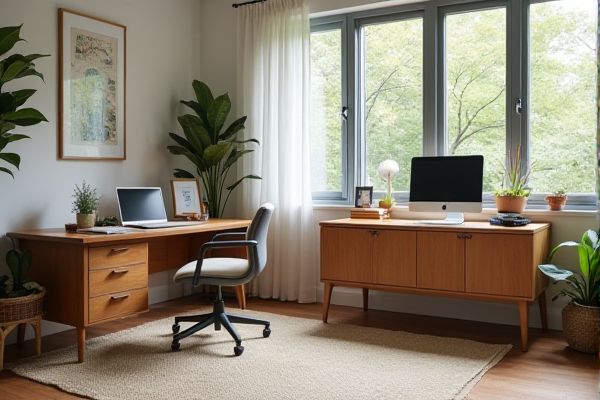
A reversible desk offers flexible workspace options by allowing you to change its configuration, enhancing functionality compared to a standard desk with a fixed design. Discover how choosing the right desk can improve your productivity by reading the rest of the article.
Table of Comparison
| Feature | Reversible Desk | Standard Desk |
|---|---|---|
| Adjustability | Height and orientation adjustable | Fixed height and orientation |
| Ergonomics | Supports sitting and standing positions | Primarily supports sitting |
| Flexibility | Can switch between multiple uses and setups | Designed for single, fixed use |
| Space Efficiency | Optimizes space with reversible surfaces | Requires dedicated space |
| Cost | Generally higher price due to mechanics | Typically more affordable |
| Maintenance | Needs occasional adjustment and lubrication | Low maintenance |
| Durability | Durable with proper care of moving parts | Durable due to simple construction |
Overview of Reversible Desks and Standard Desks
Reversible desks feature dual-sided designs allowing users to switch between different workspace layouts or functions, enhancing flexibility in various settings. Standard desks typically offer a fixed configuration optimized for single-use purposes such as writing, computing, or meetings. The reversible desk's adaptability caters to dynamic work environments, while standard desks prioritize stability and simplicity.
Key Features of Reversible Desks
Reversible desks stand out with their dual-sided functionality, allowing users to switch between sitting and standing positions effortlessly, promoting ergonomic health and boosting productivity. These desks often include adjustable height settings, spacious surfaces, and durable materials tailored for both comfort and versatility. Your workspace can benefit from a reversible desk's ability to adapt to varying tasks and preferences, enhancing overall efficiency compared to standard fixed-height desks.
Defining Standard Desks: Core Characteristics
Standard desks feature fixed dimensions and a single orientation that accommodates typical workspace setups, offering stability and simplicity in design. These desks usually include a flat work surface with integrated storage options like drawers or shelves, catering to general office or home use. Your choice of a standard desk ensures familiarity and straightforward functionality without the need for adjustment or repositioning.
Benefits of Using a Reversible Desk
Reversible desks offer versatile workspace configurations, allowing you to switch between sitting and standing positions easily, which promotes better posture and reduces the risk of sedentary-related health issues. These desks often include adjustable height settings and dual-sided surfaces that maximize office ergonomics and optimize space utilization. Choosing a reversible desk enhances productivity by accommodating different tasks and work styles, making it a practical upgrade over a standard fixed desk.
Advantages of Choosing a Standard Desk
Standard desks offer a stable, fixed workspace with a classic design that suits a variety of office settings. They typically provide more surface area and storage options compared to reversible desks, enhancing organization and productivity. Your workspace benefits from the durability and simplicity of a standard desk, ideal for consistent daily use without the need for frequent adjustments.
Design Flexibility: Which Desk Offers More?
Reversible desks provide greater design flexibility by allowing users to switch the orientation of the workspace, adapting easily to different room layouts and personal preferences. Standard desks typically have a fixed design, limiting their adaptability to varying spatial requirements. This inherent versatility makes reversible desks ideal for dynamic environments needing frequent reorganization.
Space Utilization: Reversible vs Standard Desk
Reversible desks maximize space utilization by offering flexible configurations that adapt to varying room layouts, unlike standard desks which have fixed orientations limiting placement options. Their dual-sided design allows you to switch the working surface, optimizing corner usage and accommodating different workflow needs in compact environments. Choosing a reversible desk enhances your workspace efficiency, making it ideal for both home offices and multifunctional rooms.
Ease of Assembly and Installation
Reversible desks simplify ease of assembly and installation by offering modular components that can be configured to fit your space without complex tools or hardware. Standard desks often require more time-consuming assembly with fixed orientations, limiting flexibility during setup. Choosing a reversible desk enhances convenience, letting you quickly adjust its layout to suit your evolving needs.
Cost Comparison: Reversible Desk vs Standard Desk
Reversible desks typically cost 15-25% more than standard desks due to their dual functionality and higher manufacturing complexity. Standard desks, made with simpler designs and fewer materials, offer a more budget-friendly option for basic workspace needs. Long-term value of reversible desks can outweigh initial costs by providing adaptable use and reducing the need for multiple pieces of furniture.
Which Desk is Right for You?
A reversible desk offers flexible workspace arrangements with the ability to switch desk orientations, making it ideal for dynamic environments or smaller areas where maximizing space is crucial. Standard desks provide a fixed, stable design suited for traditional setups and those prioritizing simplicity and consistency in workspace layout. Assessing your room size, workflow needs, and the frequency you rearrange your office will help determine if a reversible desk meets your demands better than a standard desk.
 homyna.com
homyna.com